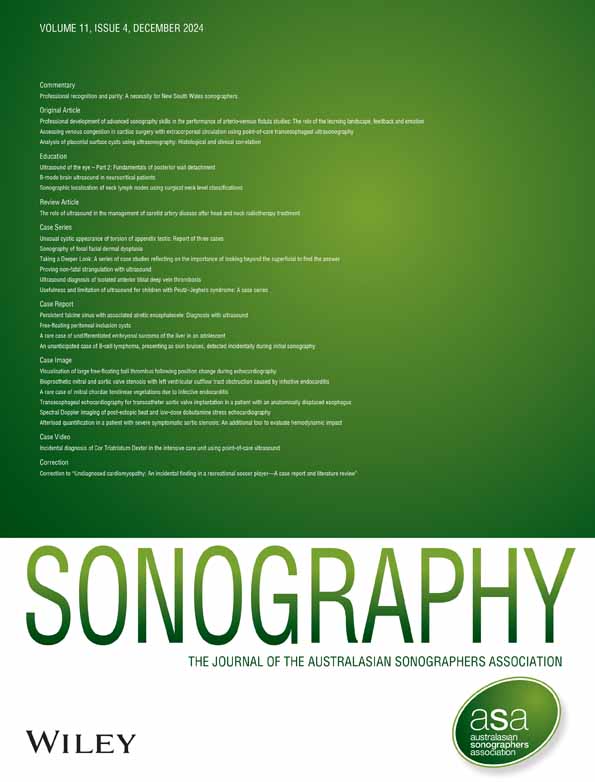B-mode brain ultrasound in neurocritical patients
Corresponding Author
María Carla Carruega
Department of Critical Care Medicine, Hospital Militar Central Cirujano Mayor Cosme Argerich, Buenos Aires, Argentina
Argentinian Critical Care Ultrasonography Association (ASARUC), Buenos Aires, Argentina
Correspondence
María Carla Carruega, Intensive Care Unit, Central Military Hospital Major Surgeon Dr. Cosme Argerich, Av. Luis María Campos 726, C1426 CABA, Buenos Aires, Argentina.
Email: [email protected]
Search for more papers by this authorJosé Alberto Feijóo
Argentinian Critical Care Ultrasonography Association (ASARUC), Buenos Aires, Argentina
Department of Critical Care Medicine, Hospital General de Agudos Bernardino Rivadavia, Buenos Aires, Argentina
Search for more papers by this authorIssac Cheong
Argentinian Critical Care Ultrasonography Association (ASARUC), Buenos Aires, Argentina
Department of Critical Care Medicine, Sanatorio De los Arcos, Buenos Aires, Argentina
Search for more papers by this authorFrancisco Marcelo Tamagnone
Argentinian Critical Care Ultrasonography Association (ASARUC), Buenos Aires, Argentina
Search for more papers by this authorCorresponding Author
María Carla Carruega
Department of Critical Care Medicine, Hospital Militar Central Cirujano Mayor Cosme Argerich, Buenos Aires, Argentina
Argentinian Critical Care Ultrasonography Association (ASARUC), Buenos Aires, Argentina
Correspondence
María Carla Carruega, Intensive Care Unit, Central Military Hospital Major Surgeon Dr. Cosme Argerich, Av. Luis María Campos 726, C1426 CABA, Buenos Aires, Argentina.
Email: [email protected]
Search for more papers by this authorJosé Alberto Feijóo
Argentinian Critical Care Ultrasonography Association (ASARUC), Buenos Aires, Argentina
Department of Critical Care Medicine, Hospital General de Agudos Bernardino Rivadavia, Buenos Aires, Argentina
Search for more papers by this authorIssac Cheong
Argentinian Critical Care Ultrasonography Association (ASARUC), Buenos Aires, Argentina
Department of Critical Care Medicine, Sanatorio De los Arcos, Buenos Aires, Argentina
Search for more papers by this authorFrancisco Marcelo Tamagnone
Argentinian Critical Care Ultrasonography Association (ASARUC), Buenos Aires, Argentina
Search for more papers by this authorAbstract
The ultrasonographic evaluation of the brain is widely disseminated, focusing on the transcranial Doppler technique, which allows the evaluation of the flows of the different arteries of the circle of Willis in neurocritical patients. In this context, for a long time the brightness mode (B-mode) has not been taken into account for the study of the pathology of the central nervous system. However, it has been shown that it can also provide valuable information in neurocritical patients by being able to identify hemorrhagic, tumoral, ischemic, traumatic and inflammatory lesions to mention some of its applications. Due to this, the B-mode should also be considered as an indispensable tool in the management of neurocritical patients.
CONFLICT OF INTEREST STATEMENT
The authors declare that they have no conflict of interest.
REFERENCES
- 1Narula J, Chandrashekhar Y, Braunwald E. Time to add a fifth pillar to bedside physical examination: inspection, palpation, percussion, auscultation, and insonation. JAMA Cardiol. 2018; 3(4): 346–350. https://doi.org/10.1001/jamacardio.2018.0001
- 2Cheong I. A case of brain aneurysm diagnosed by transcranial color-coded duplex sonography in the intensive care unit. Sonography. 2022; 9(3): 146–147. https://doi.org/10.1002/sono.12318
- 3Cheong I, Mazzola MV, Besada DA, Tamagnone FM. Utility of transcranial color-coded duplex sonography in diagnosis and monitoring of PICA aneurysm in subarachnoid hemorrhage. J Clin Ultrasound. 2023; 51(5): 931–933. https://doi.org/10.1002/jcu.23458
- 4Cheong I, Feijoo J, Tamagnone FM. Cerebral circulatory arrest diagnosed with transoral Doppler ultrasonography. J Clin Ultrasound. 2023; 51(4): 742–744. https://doi.org/10.1002/jcu.23404
- 5Cheong I, Otero Castro V, Tamagnone FM. Utility of transoral and transcranial ultrasonography in the diagnosis of internal carotid dissection: a case report. J Neurocrit Care. 2022; 15(1): 52–56. https://doi.org/10.18700/jnc.210033
10.18700/jnc.210033 Google Scholar
- 6Blanco P, Abdo-Cuza A. Transcranial Doppler ultrasound in neurocritical care. J Ultrasound. 2018; 21(1): 1–16. https://doi.org/10.1007/s40477-018-0282-9
- 7Cheong I, Tamagnone FM. Transcranial sonography used as a valuable diagnostic tool for detecting a Hemoventricle, in an intensive care unit patient. J Diagn Med Sonogr. 2024; 40(3): 301–304. https://doi.org/10.1177/87564793231216092
- 8Cheong I. Transcranial ultrasound evaluation of pituitary macroadenoma. Sonography. 2023; 11: 68–70. https://doi.org/10.1002/sono.12392
10.1002/sono.12392 Google Scholar
- 9Kapoor S, Offnick A, Allen B, Brown PA, Sachs JR, Gurcan MN, et al. Brain topography on adult ultrasound images: techniques, interpretation, and image library. J Neuroimaging. 2022; 32(6): 1013–1026. https://doi.org/10.1111/jon.13031
- 10Martín F, Ochoa J. Ecografía transcraniectomía. Rev Argent Radiol. 2015; 79(4): 205–208. https://doi.org/10.1016/j.rard.2015.03.003
10.1016/j.rard.2015.03.003 Google Scholar
- 11Seidel G, Gerriets T, Kaps M, Missler U. Dislocation of the third ventricle due to space-occupying stroke evaluated by transcranial duplex sonography. J Neuroimaging. 1996; 6(4): 227–230. https://doi.org/10.1111/jon199664227
- 12Huisman TA. Intracranial hemorrhage: ultrasound, CT and MRI findings. Eur Radiol. 2005; 15(3): 434–440. https://doi.org/10.1007/s00330-004-2615-7
- 13Chen CY, Chou TY, Zimmerman RA, Lee CC, Chen FH, Faro SH. Pericerebral fluid collection: differentiation of enlarged subarachnoid spaces from subdural collections with color Doppler US. Radiology. 1996; 201(2): 389–392. https://doi.org/10.1148/radiology.201.2.8888229
- 14Lam AH, Cruz GB. Ultrasound evaluation of subdural haematoma. Australas Radiol. 1991; 35(4): 330–332. https://doi.org/10.1111/j.1440-1673.1991.tb03040.x
- 15Meyer K, Seidel G, Knopp U. Transcranial sonography of brain tumors in the adult: an in vitro and in vivo study. J Neuroimaging. 2001; 11(3): 287–292. https://doi.org/10.1111/j.1552-6569.2001.tb00048.x
- 16Berg D, Becker G. Perspectives of B-mode transcranial ultrasound. Neuroimage. 2002; 15(3): 463–473. https://doi.org/10.1006/nimg.2001.1014
- 17Kiphuth IC, Huttner HB, Struffert T, Schwab S, Köhrmann M. Sonographic monitoring of ventricle enlargement in posthemorrhagic hydrocephalus. Neurology. 2011; 76(10): 858–862. https://doi.org/10.1212/WNL.0b013e31820f2e0f
- 18Friedrich RE. Ultrasonographically supported removal of foreign bodies of the eye lid and parapharyngeal space in a 13-year-old boy subjected to shot injuries in early childhood. GMS Interdiscip Plast Reconstr Surg DGPW. 2013; 2:19. https://doi.org/10.3205/iprs000039
10.3205/iprs000039 Google Scholar
- 19Lewis D, Jivraj A, Atkinson P, Jarman R. My patient is injured: identifying foreign bodies with ultrasound. Ultrasound. 2015; 23(3): 174–180. https://doi.org/10.1177/1742271X15579950
- 20Lasselin P, Grousson S, Souza Netto EP, Balanca B, Terrier A, Dailler F, et al. Accuracy of bedside bidimensional transcranial ultrasound versus tomodensitometric measurement of the third ventricle. J Neuroimaging. 2022; 32: 629–637. https://doi.org/10.1111/jon.12970
- 21Yikilmaz A, Taylor GA. Sonographic findings in bacterial meningitis in neonates and young infants. Pediatr Radiol. 2008; 38(2): 129–137. https://doi.org/10.1007/s00247-007-0538-6




